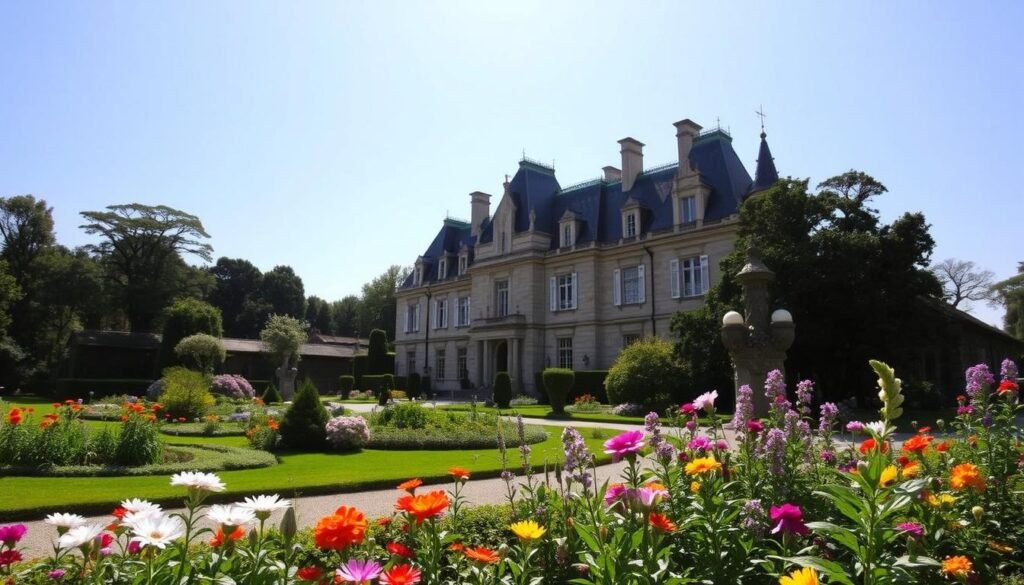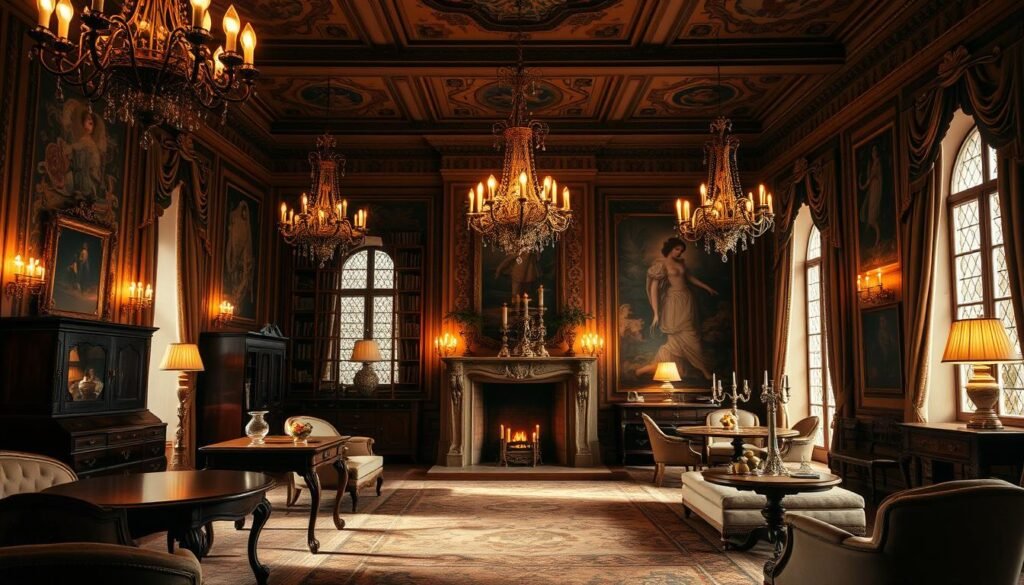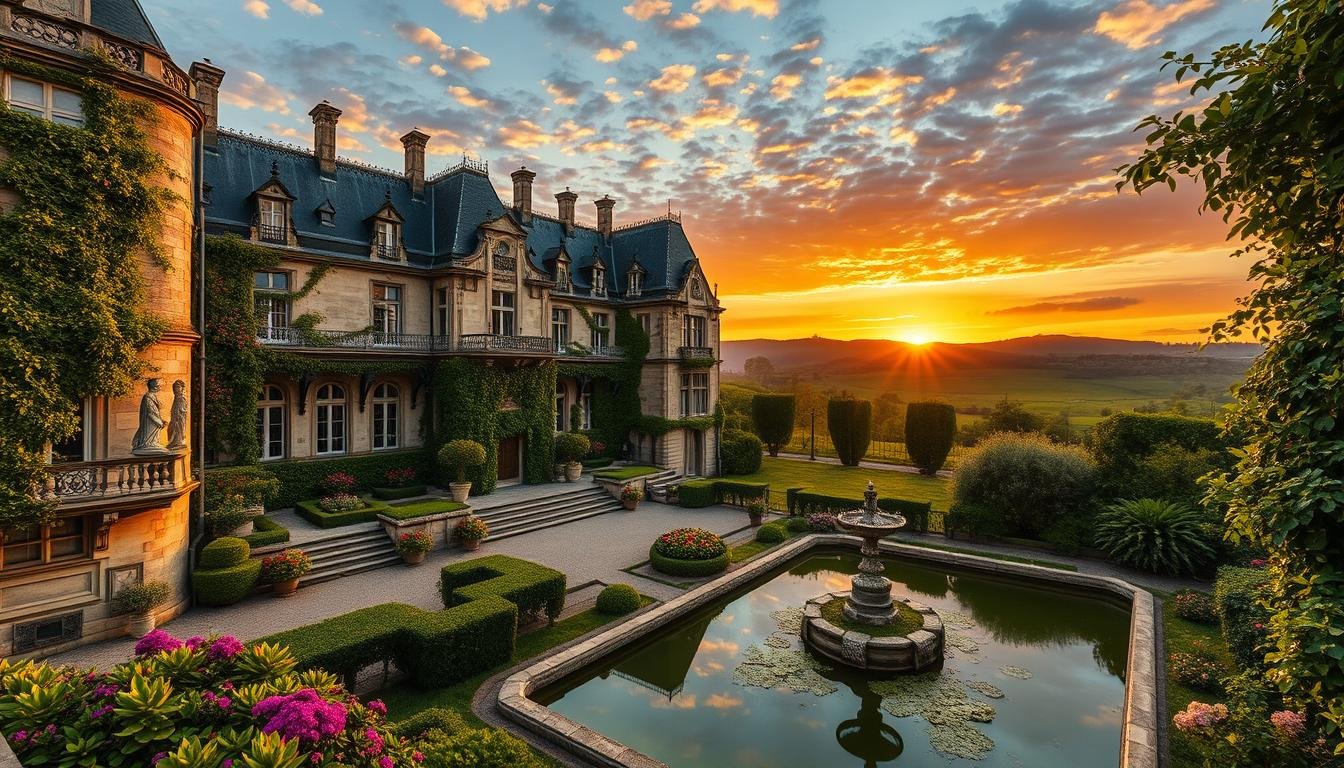Château de Purnon’s towering facade whispers tales of a bygone era. Built in 1788, it stands as a testament to French architectural heritage1. Like many French châteaux, it needs expert restoration to preserve its timeless beauty.
Over 40,000 châteaux grace France’s landscape, mostly privately owned1. These grand estates range from medieval fortresses to Renaissance palaces. They embody French history, culture, and artistic expression through the ages.
Preserving these treasures comes with great responsibility. At Château de Purnon, a registered heritage architect guides meticulous restoration work1. Public support is strong, with over 1,000 visitors during the Journées du Patrimoine event1.
Château custodians face challenges like structural decay and money issues. They use new methods and community help to revive these historic gems. Château de Purnon uses social media to build support and organizes volunteer cleanup days1.
This approach preserves the building and creates a sense of shared ownership. It keeps châteaux vibrant and open for future generations to enjoy. Château de Purnon plans to host weddings and events, showing how these structures adapt to modern needs1.
Key Takeaways
- France is home to over 40,000 châteaux, the majority of which are privately owned.
- Château restoration is crucial for preserving France’s architectural heritage, requiring expertise, dedication, and resources.
- The Château de Purnon restoration project exemplifies the meticulous care and community involvement required to safeguard these national icons.
- Innovative techniques and adaptive reuse strategies are helping to breathe new life into historic châteaux while honoring their past.
- Châteaux are not merely buildings, but living embodiments of France’s enduring spirit and cultural legacy.
The Evolution of French Châteaux Through Time
French châteaux have a rich history spanning centuries. They’ve changed from medieval fortresses to grand Renaissance palaces. France has over 40,000 châteaux built between the 9th and 21st centuries2.
These structures reflect France’s changing architectural styles and cultural heritage. Each château tells a unique story of its time and place2.
From Medieval Fortresses to Renaissance Palaces
The earliest French châteaux date back to the 10th century. They served as strongholds for feudal lords protecting their domains2.
During the Renaissance, these fortified structures evolved into elegant residences. Italian architecture and intellectuals influenced their design. They became spaces celebrating art, culture, and refined living2.
The Golden Age of Château Architecture
Louis XIV’s reign marked the pinnacle of château construction in France. His vision for the Château de Versailles set new standards2.
Versailles, with its sprawling gardens and ornate interiors, showcased France’s artistic prowess. It exemplified the ambitions of the French monarchy2.
Modern Transformations and Adaptations
French châteaux continue to evolve, reflecting changing tastes and needs. Many have been converted into boutique hotels and bed-and-breakfasts3.
Others serve as wedding venues and retreat centers. These grand estates show remarkable adaptability. Their appeal still captivates château enthusiasts worldwide2.
“French châteaux are known for their enduring construction methods and materials, such as thick stone walls and cellars providing strength and stability.”2
| Château | Location | Transformation |
|---|---|---|
| Château de la Resle | Burgundy | Converted into a boutique hotel by Johan Bouman and Pieter Franssens3 |
| Château de Gudanes | Pyrenees | Purchased by Karina and Craig Waters for a relative bargain and undergoing slow restoration3 |
| Château de Jalesnes | Loire Valley | Converted into a successful bed and breakfast by owners Catherine and Guy de Castelnau3 |
| Château de Lalande | Loire Valley | Becoming a sought-after wedding venue hosting multiple weddings annually3 |
| Château de la Verrerie | Burgundy | Restored into a luxurious bed and breakfast after acquisition for a reasonable sum3 |
French châteaux have adapted to meet changing needs over time. They’ve transformed from fortified strongholds to cultural landmarks and luxury accommodations2.
These architectural marvels continue to enchant visitors and residents alike. Their enduring legacy remains a vital part of France’s cultural heritage2.
Architectural Splendor: Defining Features of Historic Châteaux
France’s historic châteaux showcase the country’s rich architectural heritage. These stately structures were once home to French aristocracy. Their imposing facades, sprawling gardens, and opulent interiors captivate visitors4.
Key features of these châteaux include intricate stone carvings and parquet de Versailles flooring. Ornate overhangs and formal gardens add to their unique style. These elements embody French aristocratic elegance and artistic innovation56.
The Loire Valley, known as the “Garden of France,” houses many impressive châteaux. These structures show the evolution of French architecture over time. They range from fortified medieval fortresses to elegant Renaissance palaces4.
Each château in this region tells a fascinating story. They showcase power, ambition, and artistic expression. Visitors are captivated by their historical significance and architectural grandeur4.
Renovating châteaux requires careful planning and expertise. Architects, historians, engineers, and craftsmen play crucial roles. They preserve historical integrity while adding modern conveniences6.
Research into a château’s history helps identify key features to protect. This ensures these architectural masterpieces are preserved for future generations6.
The architectural splendor of historic châteaux amazes visitors. These structures, from grand Loire Valley estates to hidden gems, showcase France’s enduring artistic legacy4.
Chateau Dreaming: Tales of Restoration and Revival
Restoring a historic French château is a challenging endeavor. These architectural gems face issues like structural decay and financial hurdles. Yet, the rewards of reviving these magnificent properties are immense.
Preservation Challenges and Solutions
Château restoration balances preserving history and preparing for the future. Owners tackle outdated systems and extensive damage from neglect. Innovative techniques and respect for history help overcome these obstacles.
With the right approach, these barriers can be conquered. This paves the way for a château’s rebirth and renewed splendor.
Success Stories of Renewed Grandeur
Château de Belebat in the Loire Valley showcases what’s possible with determination. Once crumbling, it’s now meticulously restored, blending antique and modern elements.
The owners revived the château’s grounds into an English-inspired garden. Visitors can now escape to the chateau and experience true château dreaming.
Modern Conservation Techniques
Château restoration now relies on modern conservation methods. Owners use sustainable materials and energy-efficient systems to preserve these landmarks. These efforts ensure the châteaux’s survival for future generations.
Investments in upgrades, like at Château de Jalesnes, breathe new life into these gems. These renovations respect the châteaux’s timeless restoration diaries.
By tackling challenges and celebrating triumphs, we keep these French icons alive. They continue to captivate and inspire visitors worldwide78.
Living Heritage: The Cultural Significance of French Châteaux
French châteaux embody a living heritage that’s shaped France’s cultural identity9. These estates have been hubs of power, art, and intellect throughout history. From Capetian kings to Bourbon rulers, châteaux have played a crucial role in French legacy.
The grand Palais de Versailles, built by Louis XIV, stands as a prime example9. Today, these historic châteaux offer glimpses into France’s past. They also serve as venues for cultural events and tourism.
French châteaux have evolved with the nation’s artistic movements9. During the Renaissance, comfort and aesthetics became priorities over defense. Landscapers like André Lenôtre gained prominence alongside architects.
Formal French gardens of the 16th century complemented the châteaux’s grandeur9. These stood in contrast to the more informal English gardens of that era.
Preserving this heritage presents unique challenges10. The Château de la Barre, in the same family for 600 years, is a prime example. It faces significant upkeep costs, including 20,000 Euros annually for heating alone.
Extensive renovations are often necessary to maintain these historic estates10. Yet, they remain a source of pride and cultural identity for the French people. Innovative strategies ensure their continued preservation and public accessibility.

“The château required significant renovation work such as redoing the façade, changing gutters, repairing water leaks, modernizing electricity, reviewing landscaping, cleaning up the forest, and redecorating.”
These châteaux continue to captivate and inspire as guardians of France’s architectural legacy10. They stand as living testaments to the enduring spirit of the French people. Their preservation ensures that France’s rich cultural heritage remains vibrant and accessible.
From Ruins to Riches: Notable Restoration Projects
Historic châteaux in France are getting amazing makeovers. These old buildings are coming back to life. The Château de Thauvenay is a great example of this revival11.
Case Study: Château de Thauvenay
The Château de Thauvenay shows how restoration can work wonders. It was once a ruin, but now it’s alive again. A team and the local community worked hard to make this happen11.
People donated 10,900 Euros to fix the school’s roof. The school plans to reopen next year in March or April. They hope to get more students then11.
The school is getting a big makeover. They’re fixing up the classroom for the youngest kids. Local workers helped out for free during the renovations11.
The project replaced old furniture and improved the learning space all at once. Before, they could only buy one table at a time. Now, everything’s new11.
They plan to plant trees on the school grounds. This will give shade in summer and a new space for kids to enjoy. The Château family promises to keep everyone updated on the changes11.
The Versailles Influence
The famous Château de Versailles inspires many restoration projects in France. Designers copy its grand style and elegant gardens. They use similar ideas for landscaping and interior design12.
Contemporary Preservation Methods
Modern preservation uses eco-friendly methods and original materials. This keeps the châteaux true to their history. Restorers carefully maintain the old shapes and materials of these buildings12.
Château restoration is becoming more popular in France. These projects show how to honor the past. They turn forgotten buildings into lively landmarks that celebrate French culture.
The Art of Château Interior Design
Château interiors blend historical elegance with modern functionality. They preserve original features like ornate wood paneling and grand marble fireplaces. These spaces also embrace contemporary comforts, integrating period-appropriate furnishings and art13.
Château dreaming honors a property’s heritage while creating a welcoming atmosphere. Owners often include designers, architects, artists, and antique dealers. Each brings a unique vision to the restoration process13.
“French Chateau Style” showcases diverse châteaux, from medieval fortresses to 18th-century noble homes. These interiors feature traditional fabrics, tapestries, and rugs. They create a sense of timeless elegance13.
The French château interior design trend is gaining popularity. Pinterest data shows over 7,000 searches for “Château interiors”. Related terms like “Chateau style” and “French House Interiors” also see strong engagement14.

Restoring these architectural gems showcases the appeal of French heritage. They serve as guest spaces and serene sanctuaries for owners. As the “12 days of château christmas” nears, château interiors become even more enticing1314.
Gardens and Landscapes: Preserving Historic Grounds
Restoring historic château grounds is vital for protecting French legacies. Many estates showcase formal French gardens inspired by Versailles. These gardens feature geometric parterres, water features, and carefully maintained landscapes15.
French Formal Garden Restoration
Landscape designers aim for historical accuracy when restoring château gardens. They carefully recreate original layouts and plant species. This effort transports visitors back in time, showcasing the timeless beauty of these gardens15.
Water Features and Fountains
Water features are key in French formal gardens. Designers revive cascading waterfalls, reflecting pools, and ornate fountains. These elements create a mesmerizing ambiance in historic grounds15.
The sound of flowing water adds to the overall experience. Visual spectacles of these features captivate visitors to château landscapes15.
Historical Accuracy in Landscape Design
Designers focus on historical details when preserving château gardens. They research original plant species, materials, and design principles. This ensures authenticity in restoration efforts15.
Modern sustainable practices are incorporated while maintaining timeless essence. These culturally significant spaces continue to inspire and awe visitors15.
Preserving château grounds goes beyond restoring physical landscapes. It safeguards the cultural and historical significance of these iconic spaces. Châteaux adapt to modern needs while maintaining their enduring legacy1516.
| Château | Visitor Numbers | Notable Features |
|---|---|---|
| Sissinghurst Castle Garden | Over 100,000 annually16 | Tudor buildings, iconic tower, original moat, Mediterranean-style Delos gardens, summer writing gazebo16 |
| Château de Thauvenay | N/A | Formal French gardens, restored water features, historically accurate landscape design |
Landscape designers and preservation experts are guardians of these spaces. They ensure château gardens remain vibrant and relevant for future generations15.
Sustainable Preservation: Modern Approaches
Historic French châteaux preservation is evolving to embrace sustainable practices17. The château dreamer’s toolkit now includes energy-efficient systems and eco-friendly restoration materials. These strategies balance historical authenticity with environmental consciousness.
Château dreaming now focuses on safeguarding architectural legacies while minimizing ecological footprints17. Professionals now seek input from various stakeholders, including local communities. This ensures preservation decisions reflect diverse values and priorities.
- Values-centered preservation is gaining traction as a planning tool17. It focuses on understanding multiple meanings attributed to heritage sites.
- Comparative data suggests this approach can be more effective in preserving cultural value17. It outperforms traditional strategies that prioritize historical accuracy.
- This shift reflects growing emphasis on inclusivity, community engagement, and environmental sustainability17.
Modern approaches shape how we engage with historic sites18. By embracing sustainable practices and diverse perspectives, château dreaming ensures these treasures inspire future generations.
“Preserving the past while building for the future is the ultimate challenge in château restoration. It’s a delicate balance that requires creativity, innovation, and a deep respect for history.” – Château Dreamer, Jane Doe
Castle Elvira’s restoration in Puglia, Italy, involved clearing 37 acres of wilderness19. Rotted stairs were replaced, showcasing extensive efforts needed to revive historic structures.
Ashford Castle’s renovation in Ireland replaced 800 windows and 10,764 square feet of lead roofing19. Materials from around the world preserved over eight centuries of history.
Sustainable preservation practices are crucial for safeguarding architectural gems17. The château dreamer’s toolkit ensures rich legacies endure while minimizing environmental impact.
Conclusion: Safeguarding French Architectural Legacy
Preserving French châteaux is vital for maintaining the country’s rich architectural and cultural heritage20. Dedicated restoration efforts and innovative conservation techniques keep these magnificent structures inspiring and educational. They serve as a bridge between past and present20.
The challenge lies in balancing preservation with accessibility. We must ensure these iconic châteaux remain relevant and appreciated in today’s world. From Paris’ modern buildings to Château de Villette’s grand Baroque landscaping, French châteaux shape the nation’s identity2021.
By safeguarding these historic structures, we preserve France’s rich past. We also protect the intangible memories, stories, and traditions that bring “château histories” to life20. Our duty is to keep the “château living” experience accessible for future generations.
Preservationists, architects, and cultural enthusiasts work together to protect French architectural legacy21. Their efforts ensure these cherished châteaux continue to captivate and enchant. By adapting past lessons to present needs, we can safeguard these marvels for centuries to come.
FAQ
What are the key features that define historic French châteaux?
What are some of the challenges associated with château restoration?
How do château interiors blend historical elements with modern functionality?
What role do gardens and landscapes play in château preservation?
How are modern château preservation efforts focused on sustainability?
Source Links
- The Australian Couple Saving a French Château
- How Purchasing a French Castle is Investing in your own History
- Unveiling the French Chateau Dream: Your Guide to Affordable Renovation and Ownership – Saving Castles
- Chateaux of the Loire Valley: A complete guide – Brocante Ma Jolie
- American Splendor vs. French Grandeur: A Showdown of America’s Top 10 Historic Mansions vs. Top 10 French Châteaux
- Bridging Centuries: Unveiling the Balance in Historic Chateau Renovation – Saving Castles
- Resurrecting a Renaissance Treasure: The Ambitious Renovation of Chateau de Belebat – Saving Castles
- Dream castle homes and real château renovations
- Brief History of French Castles over time
- La Vraie Vie de Château – My French Life™ – Ma Vie Française®
- From Ruin to Renaissance: The Makeover Of A French School With The Chateau Family
- French Chateau de gudanes Rescued from Ruin
- Thrilling New Style and Design Book: ‘French Chateau Style Inside France’s Most Exquisite Country Houses’ by Catherine Scotto and with photography by Marie Pierre Morel
- Chateaux Interiors
- Project MUSE – Georgia’s Barnsley Gardens: Preserving a Landscape of the Lost Cause
- Let’s Go: Sissinghurst Castle Garden Part I
- Theoretical and Practical Arguments for Values-Centered Preservation
- Modern Conservation Principles and Their Application in Mediterranean Historic Centers—The Case of Valletta
- Castle Renovation: How to Live in a Modern Fairy Tale
- Paris architecture ➤ A brief history • Paris Property Group
- Inside France’s Historic Chateau de Villette A 17th Century Estate Where Luxury Meets Cultural Heritage
